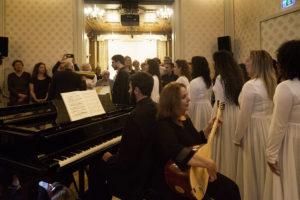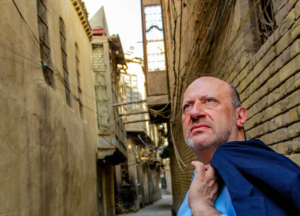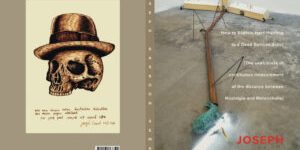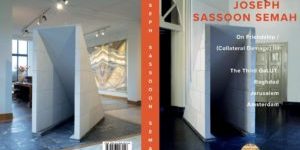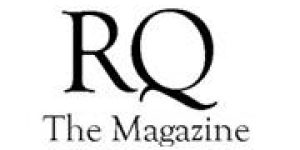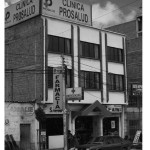Art Manifestation ‘On Friendship/(Collateral Damage) III – The Third GaLUT: Baghdad, Jerusalem, Amsterdam’ ~ The Guest Becomes Host
No comments yet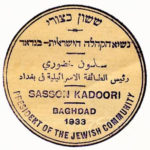 Joseph Sassoon Semah shares his lost rich Jewish Babylonian cultural heritage through art, performances and debates. He asks the public to review their own art, culture, traditions and identity.
Joseph Sassoon Semah shares his lost rich Jewish Babylonian cultural heritage through art, performances and debates. He asks the public to review their own art, culture, traditions and identity.
The manifestation takes place mainly in 36 different public locations in Amsterdam, from September 7th 2019 – January 19th 2020.
Nederlandstalig: http://rozenbergquarterly.com/gast-wordt-gastheer/
Stichting Metropool Internationale Kunstprojecten
Curator: Linda Bouws.
On Friendship/(Collateral Damage) III – The Third GaLUT: Baghdad, Jerusalem, Amsterdam is an aesthetic and poetic research into the cities Baghdad, Jerusalem and Amsterdam, which has been conceived by artist Joseph Sassoon Semah and curated by Linda Bouws (Metropool International Art Projects). All these cities are said to have been tolerant at some time in their history, but how does that relate to ‘otherness’ and what does it mean today? The project focuses on two lines of thought. The first is what Semah called ‘The Third GaLUT’, the third Exile, a metaphor for disconnectedness.
The second is ‘The Guest’, he who is allowed to live and work in a foreign context tests his surroundings the very moment he articulates his particular position in exile without any reservations.
The Guest becomes Host. By this process Semah investigates one of the greatest achievements of human civilisation: hospitality. Joseph Sassoon Semah translates his cultural and visual heritage and its subtext into contemporary art. While doing so he reassesses and redefines lost heritages.
The project will translate the cultural heritage of Baghdad, Jerusalem, and Amsterdam, with the help of the different ‘Guests’, into a meaningful experience for a broad audience.
In On Friendship/(Collateral Damage) III – The Third GaLUT: Baghdad, Jerusalem, Amsterdam, Joseph Sassoon Semah shares his lost rich Jewish Babylonian cultural heritage and asks the public to review their own art, culture, traditions and identity. This will take place mainly in 36 public locations
in Amsterdam.
There will be new pieces of art, performances, debates, lectures, round-table discussions, video-interviews, a publication in English, articles on diverse platforms, a research – and a video-report.
Simultaneously in Amsterdam, Baghdad and Jerusalem a small house will be built: MaKOM in MaKOM. The project will translate the cultural heritage of Baghdad, Jerusalem and Amsterdam, with the help of different ‘Guests’, into a meaningful experience for a broad audience.
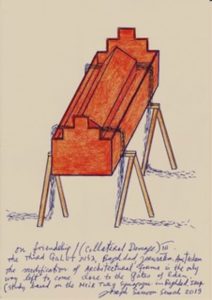 Artist Joseph Sassoon Semah
Artist Joseph Sassoon Semah
Artist Joseph Sassoon Semah was born in Baghdad (Iraq, 1948), as one of the last of a Babylonian Jewish family lineage, the grandson of Chief Rabbi Hacham Sassoon Kadoori (1885-1971). Kadoori was the head of the Babylonian Jewish community and preached of peace between Judaism, Islam and Christianity. Baghdad once was one of the most diverse an tolerant cities in the world. The Babylonian Jews in Iraq were one of the oldest and historically seen, the most important Jewish community. The Talmud Bavli was compiled in Babylon and during the British mandate in the 1920s, the well-educated Jews played an important role in public life. But from 1948, the year of independence for Israel, life for Jews in Iraq becomes extremely difficult.
Between 1950-1952, 120.000 – 130.000 Iraqi Jews were transported to Israel. The displaced Baghdadi Jews were forced to leave behind their culture and possessions in Iraq. Semah, together with his parents was displaced to the State of Israel in 1950. His grandfather Hacham Sassoon Kadoori refused to leave Iraq and stayed in Bagdhad until his death. His experiences in the Six Day War (1967) and the Yom Kippur War (1973) resulted in Joseph Sassoon Semah deciding to leave Israel: in this context he calls this a self-imposed exile.
As a Babylonian Jew who emigrated to the West (Amsterdam), he is part of GaLUT (Exile), an endless cycle of diaspora and return. You long for your country of birth and search for a way to relate to your cultural heritage and traditions. Heritage reminds us of our history.
On Friendship/(Collateral Damage) III – The Third GaLUT: Baghdad, Jerusalem, Amsterdam
For this project Joseph Sassoon Semah designs a new series of drawings and scale-sized architectural models of houses, cultural institutions, synagogues and Jewish burial places in Baghdad from before 1948, that refer to their rich history.
At all 36 locations there will be an architectural art-model on show for at least a month, and activities will be organised with the partners.
On Friendship/(Collateral Damage) III – The Third GaLUT: Baghdad, Jerusalem, Amsterdam was realised in part with the support of AFK, BPD Cultuurfonds, Lumen Travo Gallery, Mondriaan Fonds and Redstone Natuursteen & Projecten.
Please mark the following data in your calendar and keep an eye out for our next newsletters or stay up-to-date at http://rozenbergquarterly.com/category/meritis_makom/ and www.josephsemah.nl
On Friendship/(Collateral Damage) III – The Third GaLUT: Baghdad, Jerusalem, Amsterdam will take place in 36 places:
1. Location: Lumen Travo Gallery, Lijnbaansgracht 314, Amsterdam
Date: 7 September – 26 October 2019
Exhibition, performance and meetings, opening 7 September, 17.00 hrs.
On Saturday 7 September at 5 pm: opening of On Friendship / (Collateral Damage) III – The Third GaLUT: Baghdad, Jerusalem, Amsterdam.
Performance: Joseph Sassoon Semah, Baruch Abraham, Peter Baren, Zuhal Gezik, Jom Semah.
Exhibition: drawings from the new series ‘Between Graveyard and Museum’s sphere’, paintings, sculptures and a model cast in bronze of the Meir Tweig Synagogue of Hacham (Chief Rabbi) Sassoon Kadoori, who was also president of the Babylonian community in Iraq.
He lived from 1885-1971. Artist Joseph Sassoon Semah is his grandson. The model, key work of the project, will later be exhibited at other locations.
Lumen Travo Gallery, the gallery of Joseph Sassoon Semah, is the home of the entire event.
A space is also available as an information and research place and ad hoc lectures and meetings are organized for a small audience.
2. Location: Advocatenkantoor Bynkershoek, Herengracht 310, Amsterdam
Date: 24 September – 6 October 2019
Art and private meeting 24 September, 18.00 hrs.
3. Location: Goethe-Institut Amsterdam, Herengracht 470, Amsterdam
Date: 12 September – 12 October 2019
Lecture & Performance, 12 September, 20.00 hrs.
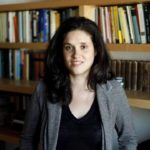 Lecture: dr. Yael Almog, Goethe Universität Frankfurt
Lecture: dr. Yael Almog, Goethe Universität Frankfurt
The lecture will engage with the presentation of the East in the works of the great German poet Johann Wolfgang von Goethe particularly in his major work on Eastern aesthetics, the West-Östlicher Divan. In his Divan, Goethe portrays the possibility of cultural exchange through art between the East and the West. What was the meaning of this vision in Goethe’s time? How can we understand the West-östlicher Divan in light of contemporary polemics on migrants and refugees? The Israeli migration to Western Europe will be taken as a unique case study with which to examine the contemporary validity of Goethe’s vision.
Performance:
Joseph Sassoon Semah, Baruch Abraham, Levent Aslan and Zuhal Gezik – Aslan Muziekschool with 6 students, Dali Heymann, Uzi Heymann, Atousa Bandeh, Peter Baren, Mikko Fritze, Jom Semah, Yvonne Strang and Els Wijnen.
4. Location: Aslan Muziekcentrum, Corantijnstraat 9, Amsterdam
Date: 15 September – 13 October 2019
Art, performances with students
In On Friendship/ Collateral Damage) III – The Third GaLUT: Baghdad, Jerusalem, Amsterdam we will organize various performances. Zuhal Gezik, artistic director of Aslan Music Center, with six students, and Levent Aslan, are part of several performances.
5. Location: UvA, Faculteit des Geesteswetenschappen, P.C. Hoofthuis, Spuistraat 134, Amsterdam
Date: 18 September – 18 October 2019
Artwork
6.Location: UvA, Duitsland Instituut, Bushuis Kloveniersburgwal 48, Amsterdam
Date: 18 September 2019
College: Prof. dr. A.J.J. (Ton) Nijhuis, Duitsland Instituut/ chair of faculty politicology
Since the late 1970s, artist Joseph Sassoon Semah has developed an encyclopedic artistic oeuvre. Sassoon Semah was born in Baghdad and moved with his family to Jerusalem in 1950. Sassoon Semah now lives in Amsterdam. His research focuses on the relationship between Jewish identity and modernist art. Modernist art is based on exclusion principles. Sassoon Semah was one of the first artists to criticize these mechanisms in the Dutch context. He asks the simple question of what modernism looks like from a Jewish perspective. As a result, he has not only uncovered unknown layers in modern art, but has also drawn attention to the destroyed intellectual climate of Baghdad before 1950.
Followed by private visit:
September 18, visit Stedelijk Museum Amsterdam
Visit Stedelijk Museum Amsterdam: Dr. A.S. (Anna) Seidl, Prof. dr. A.J.J. (Ton) Nijhuis, artist Joseph Sassoon Semah and students.
Joseph Sassoon Semah is a versatile artist whose work includes drawings, paintings, sculptures, installations, performances and texts. Sassoon Semah has been studying and researching the relationship between Judaism and Christianity as sources of Western art and cultural history for more than forty years. By reading in his native language, Hebrew, he signals a lack of Jewish knowledge and the urgency to add it and fill the “blank page” . With his own work he “corrects” art history, philosophy and theology. He argues for more attention for different sources in order to create broader support for other visions.
7. Location: privé-huis Prof. mr. E.J. (Egbert) Dommering
Date: 19 September – 19 October 2019
Art and private
Meeting 19 September, 19.00 hrs.
Meeting: Introduction prof. E.J. (Egbert) Dommering: About the exclusion of mixing and appropriation of cultures in the visual arts.
In the art world, artists regularly refer to other people’s work. There is a vague boundary between incorporating forms and ideas from a different culture into one’s own and appropriating or excluding them. This will be explained on the basis of a number of examples as an introduction to a discussion about this phenomenon in relation to the work of Joseph Sassoon Semah.
8. Location: Gallery ARTTRA, Tweede Boomdwarsstraat 4, Amsterdam
Date: 5 October – 30 October 2019
Exhibition: opening 5 October 2019, 17.00 hrs.
9. Location: The Jerusalem Biennale 2019 For Heaven’s Sake, Kol HaOt in Huzot Hayotzer in Jerusalem
Date: 10 October – end November 2019
Exhibition, performance, opening 10 October 2019
MaKOM in MaKOM by Joseph Sassoon Semah is exhibited at the Jerusalem Biennale. As a Babylonian Jew who emigrated to the West (Amsterdam), Joseph Sassoon Semah is part of GaLUT (Exile), an endless cycle of diaspora and return. You long for your country of birth and search for a way to relate to your cultural heritage and traditions. Heritage reminds us of our history. Sassoon Semah built ‘temporary houses’ in various parts of the world since 1979
as a reminder of his GaLUT. The houses are recognizable as ‘portable homeland’, especially for those who live in exile. The house symbolizes the place where the Jew can only live temporarily. As long as the diaspora lasts, GaLUT itself remains a temporal location, a MaKOM in MaKOM which must be formally replaced by another MaKOM in MaKOM.
The other two houses MaKOM in MaKOM that are part of the project On Friendship / (Collateral Damage) III – The Third GaLUT: Baghdad, Jerusalem, Amsterdam are placed in Hermitage Amsterdam (November 2- 2 December) and in Baghdad for the synagogue Meir Tweig. This was the synagogue of Hacham (Chief Rabbi) Sassoon Kadoori (1885-1971). Joseph Sassoon Semah is his grandson.
10. Location: Museum Hedendaagse Kunst De Domijnen, Ligne 5, Sittard
Date: 20 October 2019 – 26 Januari 2020
Retrospective Joseph Sassoon Semah: opening 20 October, 13.00 hrs.
A large retrospective with artworks by Joseph Sassoon Semah: “Being touched by an angel just before birth.” Curator: Roel Arkesteijn.
Joseph Sassoon Semah in gesprek met Roel Arkesteijn in De Domijnen, Sittard over de tentoonstelling “Being Touched by an Angel Just Before Birth”
20 oktober 2019 – 16 februari 2020. Ligne5, Sittard
11. Location: Oude Lutherse Kerk, Singel 411, Amsterdam
Date: 13 October – 10 November 2019
Art
Performances and meeting: 13 October, 12.15 hrs.
Host: Andreas Wöhle, president Evangelisch-Lutherse Synode in the Protestantse Kerk, preacher of the Evangelisch-Lutherse Gemeente Amsterdam
Performance ‘Back to Back’ Joseph Sassoon Semah with among others Andreas Wöhle, and rabbi Mustafa Slaby.
Performance with public: ‘Yusuf, Yosef, Joseph’ and discussion with representatives from several communities.
12. Location: Podium Mozaïek, Bos en Lommerweg 191, Amsterdam
Date: 17 October – 17 November 2019
Opening, performance and meeting: 17 October, 19.30 hrs.
Art: Joseph Sassoon Semah – Graftombe Ezra
Performance: Joseph Sassoon Semah, Levent Aslan, Baruch Abraham, Uzi Heymann, Zuhal Gezik and six students Aslan Muziekschool, Anna Seidl, Jom Semah, Rick Vercauteren.
Lecture: Rick Vercauteren, art historian/publicist ‘Architecture in GaLUT’ – Joseph Sassoon Semah translates his cultural and visual heritage and its subtext into contemporary art. While doing so he reassesses and redefines lost heritages. Dialogue between Vercauteren and artist Joseph Sassoon Semah.
Performance: Joseph Sassoon Semah, Levent Aslan, Baruch Abraham, Mudar Adas, Uzi Heymann, Zuhal Gezik and six students Aslan
13. Location: Kunstenaarsboekwinkel Boekie-Woekie, Berenstraat 16, Amsterdam
Date: 19 October – 15 November 2019
Exhibition: opening 19 October 2019, 17.00 hrs.
14. Location: Werkgebouw het Veem, Van Diemenstraat 410-412, Amsterdam
Date: 25 October – 24 November 2019
Exhibition
15. Location: Embassy of the Free Mind, Keizersgracht 123, Amsterdam
Date: 31 October 2019, 19.00 hrs.
Art and lecture
Joseph Sassoon Semah: The meaning of Tetragrammaton and Pentagrammaton and The Black Square (EN)
What is the Tetragrammaton, or even the Pentagrammaton? We often see the image of the Tetragrammaton and Pentagrammaton in art and culture, but also in the work of artist Joseph Sassoon Semah (Iraq, 1948) and in the collection of The Embassy of the Free Mind.
In this lecture Joseph Sassoon Semah will reflect on the work of Barnett Newman, Marcel Duchamp, Giovanni Pico della Mirandola; Johannes Reuchlin and Vincent van Gogh and their sources of inspiration and the collection of the Embassy of the Free Mind.
Joseph Sassoon Semah will also talk about the meaning of The Black Square, the reference to the destruction of the Second Solomonic Temple reconstructed by Herod (29 or 30 July 70 C.E.), and the perfection of its dimensions.
Voor meer info en reserveren: https://embassyofthefreemind.com/nl/evenementen#LJSS
16. Location: Hermitage Amsterdam, Amstel 51, Amsterdam
Date: 2 November – 2 December 2019
Art and House MaKOM in MaKOM on the bleachfield, performance, opening Night of the Museum 2 November, 19.00 hrs.
Performance Museumnacht Joseph Sassoon Semah, Baruch Abraham, Levent Aslan, Peter Baren, Uzi Heymann, Zuhal Gezik with six students Aslan Muziekschool, Anna Seidl, Jom Semah, Yvonne Strang, Els Wijnen and Pierre Bokma.
Joseph Sassoon Semah has built ‘temporary houses’ in various parts of the world since 1979 as a reminder of his GaLUT. The houses are recognizable as ‘portable homeland’, especially for those who live in exile. The house symbolizes the place where the Jew can only live temporarily. As long as the diaspora lasts, GaLUT itself remains a temporal location, a MaKOM in MaKOM which must be formally replaced by another MaKOM in MaKOM.
The other two houses MaKOM in MaKOM that are part of the project On Friendship / (Collateral Damage) III – The Third GaLUT: Baghdad, Jerusalem, Amsterdam are placed in the Jerusalem Biennale (10 October – late November) and in Baghdad for the synagogue Meir Tweig. This was the synagogue of Hacham (Chief Rabbi) Sassoon Kadoori (1885-1971). Joseph Sassoon Semah is his grandson.
17. Location: Vrijmetselaars Stichting Amsterdam, Vondelstraat 39, Amsterdam
Date: 3 November – 1 December 2019
Art
Performance and meeting: 3 November, 14.00 hrs.
Performance: Joseph Sassoon Semah, Baruch Abraham, Levent Aslan, Peter Baren, Zuhal Gezik with six students Aslan Muziekschool, Jom Semah and Jan W.Treffens.
Joseph Sassoon Semah and Jan W. Treffers (La PAIX lodge) will play chess and reflect on the sources and the use of symbols and the never-completed process of building the Second Temple of King Solomon. The meaning of On Friendship / (Collateral Damage) is also discussed.
18. Location: Fatih Moskee, Rozengracht 150, Amsterdam
Date: 14 November – 12 December 2019
Art
19. Location: Locus Solus (Artist in Practise), Oudezijds Voorburgwal 131, Amsterdam
Date: 16 November – 14 December 2019
Saturday 16 November 2019 – 17.00 hrs.
Exhibition: Confrontation II: ‘On Friendship/(Collateral Damage) III – The Third GaLUT: Baghdad, Jerusalem, Amsterdam’. The Guest becomes Host. Joseph Sassoon Semah and franck gribling.
en
Peter Baren: 3 photoworks Title: ARK [On Hope And Other Terminal Bodies], 2007
Saturday 7 December 2019, 17:00 hrs.
Discussion on the role of Alternative Artists Spaces in the past and present. Moderated by Albert van der Weide. Participants: Joseph Sassoon Semah (Stichting MaKOM), franck gribling (City Thoughts Foundation and Locus Solus), ieke Trinks (performance en beeldend kunstenaar), Arnisa Zego (RONGWRONG), Peter Baren (independent Performing Artist) and Martin Uit den Bogaard (De Branderij, Antwerpen).
Opening hours: Saturdays – 13.00 – 18.00 hrs.
20. Location: Hilton Hotel, Apollolaan 138, Amsterdam
Date: 17 November – 15 December 2019
Art
Film and meeting : 17 November 2019, 15.00 hrs.
Special Guest: Edwin Shuker: Remember Baghdad, 2016, 69 min. A Spring Films and Echodocs Production, director Fiona Murphy
Iraq’s last Jews tell the story of their country.
Five families from the Jewish community look back on a barely imaginable time in Baghdad – Iraq was booming. It was a city of pleasure seekers, and there was inter-communal trust. Iraq was once of the most diverse places on earth, more tolerant of its minorities than any European nation.
Today, after decades of war and instability, Iraq is a very different place. In spite of the danger, North Londoner Edwin Shuker decides to return to the country he loved. We follow him back to Baghdad. He wants to buy a house in Iraq so that he can say “The Jews have not all gone.” He wants to plant a seed of hope for the future.
With vivid home movies and archive news footage.
21. Location: Anne Frank Huis, Keizersgracht 192, Amsterdam
Date: 21 November – 19 December 2019
Art
Performance and meeting: 21 November 2019, 15.00 hrs.
Joseph Sassoon Semah & writer-poet Mati Shemoelof (Berlin), both of them Baghdadi Jews living in Europe: The Babylonian Jew in the West, The West in the Babylonian Jew: Re-Thinking the concept of GaLUT, Re-claiming the lost Culture. Moderator: Markha Valenta.
They will discuss Judaism, diaspora, exclusion, and acts of concealment and building.
RSVP: communicatie@annefrank.nl
22. Location: Amsterdam Museum Regentenkamer, Nieuwezijdsvoorburgwal 359, Amsterdam
Date: 23 November – 22 December 2019
Art
Guided tours Joseph Sassoon Semah New Narratives: 23 November and 24 November 2019
23. Location: Architectenbureau Jowa, Prinsengracht 526, Amsterdam
Date: 28 November – 29 December 2019
Art
Private Meeting: 28 November 2019, 17.00 hrs
Home no more home to me, whither must I wander?
After a musical prelude and reading of one of the Songs of Travel Jowa will briefly speak about being in exile, being an emigrant and carrying a mix of cultural identities. Followed by a conversation with Joseph about house / home / place, integration, assimilation and friendship.
24. Location UvA, Faculteit des Geesteswetenschappen Bushuis, Kloveniersburgwal 48, Amsterdam
Date: 2 December 2019 – 2 January 2020
Art
Location: SPUI25, Spui 25, Amsterdam
Date: Meeting and film, 2 December 2019, 17.00 hrs.
Location: SPUI25, Spui 25-27, Amsterdam
2 December 2019, 17:00 hrs.
Keynote Lecture Professor Ella Shohat: Remainders Revisited: An Exilic Journey from Hakham Sasson Khdhuri to Joseph Sassoon Semah with screening of the film Forget Baghdad
In her keynote lecture Professor Ella Shohat (New York University) will reflect on the significance of place in the narration of the displaced Jewish-Iraqi community in the wake of overpowering political forces that, in one form or another, generated a historical vortex that rendered impossible a millennial existence in Mesopotamia.
The enormous task of shepherding a Jewish community massively impacted by internal and external political pressures after the fall of the Ottoman empire and the establishment of the state of Iraq fell largely on the shoulders of the Hakham Bashi (the Chief Rabbi and also the President of the Iraqi Jewish Community), Sasson Khdhuri, the grandfather of artist Joseph Sassoon Semah. Although the majority of Iraqi Jews were dislocated in the wake of the partition of Palestine and the establishment of the state of Israel, the Hakham stayed to safeguard those who remained in Iraq, living through wars,
revolutions, and a dictatorial regime that rendered hellish the situation of all Iraqis, but especially of Jews, existing as they did under the unrelenting suspicion of disloyalty. At the same time, some of the Hakham’s children moved to Israel where the Iraqi-Jews, along with Sephardi/Middle Eastern Jews
more generally, experienced exclusion, rejection, and otherization as Arabs/ Orientals.
Against this backdrop, one can appreciate the self-exiling of some Mizrahim, including that of the grandson of the Hakham Bashi, artist Joseph Sassoon Semah, who left Israel in 1974 and has been living in Amsterdam since 1981. Tracing the familial passage from the Hakham’s decision to remain in Iraq to his grandson’s decision to depart from Israel encapsulates the fraught trajectory of a shattered community. These simultaneously in-place and out-of-place figures allegorize the unsettled story of Jewish-Iraq.
In her keynote lecture Professor Shohat will explore some of the motifs in the work of Joseph Sassoon Semah to illuminate the twinned loci of “Zion” and “Babylon” in the present-day formation of contradictory affiliations and paradoxical notions of “exile” and “diaspora.” The emphasis on a “Third Galut” in particular will serve to unfold a tale of a Jewish rupture from an accustomed Arab cultural geography, as re-membered by the descendants of those forced to abandon the land between two rivers, resulting in a lingering feeling of at once homelessness and at-home-ness.
Ella Shohat is professor at the departments of Art & Public Policy, Middle Eastern & Islamic Studies (Tisch School of the Arts) at New York University.
Moderation and comment by David Wertheim, historian and director of the Menasseh ben Israel Institute for Jewish Cultural and Social Studies.
Welcome: Linda Bouws (curator ‘On Friendship/(Collateral Damage) III – The Third GaLUT: Baghdad, Jerusalem, Amsterdam’)
After the lecture, an academic screening of the award-winning documentaryForget Baghdad will be hosted at the Goethe Institute Amsterdam, Herengracht 470, Amsterdam.
The extraordinary film Forget Baghdad (Jury Prize, Locarno 2002) offers a rare glimpse into a community which is little-known but extremely important in light of the current crises in the Middle East: the group variously known as “Sephardis,” “Mizrahim” or “Arab Jews,” that is, people of Jewish religion but Arab culture. The Iraqi Jews, specifically, represent a millennial tradition of Jewish presence in the region, where they formed an integral part of the society and often achieved high positions in politics, finance, and the arts. Yet they were uprooted virtually overnight in the wake of the Israeli-Palestinian conflict. Organized around the moving lives of four Iraqi-Israeli writers (Shimon Ballas, Sami Michael, Samir Naqash, Mousa Houry), former members of the communist party, Forget Baghdad reopens a lost chapter of Middle Eastern history.
If you would like to attend the screening, please register by mail to: aanmeldingen-dia@uva.nl
Metropool International Art Projects in collaboration with Menasseh ben Israel Instituut, University of Amsterdam, SPUI25, Joods Cultureel Kwartier en Duitsland Instituut Amsterdam.
Official language: English
Free Entrance. Registration via Spui25.nl (lecture) and aanmeldingen-dia@uva.nl (film)
25. Location: Kunstenaars sociëteit Arti en Amicitiae, Rokin 112, Amsterdam
Date: 3 December 2019 – 3 January 2020
Art
Performance and meeting: 3 December 2019, 16.30 hrs.
Performance Joseph Sasson Semah, Peter Baren, Uzi Heymann, Jom Semah.
As early as 1993, Joseph Sassoon Semah organized “The Third Exile” in Arti and Amicitiae.
Interview Renée Hartog (cultural diplomat / political scientist) with Joseph Sassoon Semah: ‘What does GaLUT (Exile) mean then and now?’
26. Location: Voormalig Burgerweeshuis van Aldo van Eyck, IJsbaanpad 1, Amsterdam
Date: 10 December 2019 – 12 January 2020
Exhibition
Opening and meeting: 10 December 2019, 19.00 hrs.
Guided tours: 14 December, 12.00-13.30 hrs. & 11 January, 12.00- 12.30 hrs.
Joseph Sassoon Semah: ‘Architecture in Exile’, followed by a conversation with Sharon Oldenkotte-Vrolijk of BPD, Director of Art & Culture.
The lecture is preceded by the opening of the exhibition.
27. Location: AMSU, Weesperzijde 34, Amsterdam
Date: 12 December 2019 – 12 January 2020
Art
Private meeting: 12 December 2019, 17.00 hrs.
Steve Austen “Cultural heritage: tangible and intangible heritage”
How can lost cultural heritage regain meaning?
Joseph Sassoon Semah was born in Baghdad and was ‘moved’ to Israel in 1950. In Iraq there is no longer any memory of the once powerful Jewish Babylonian community. The Babylonian culture has been destroyed three times: in Iraq, in Israel, but also in Europe, it hardly ever plays a role. Although buildings have a meaning limited in time, they live on in the soul. Or is could it be that the spiritual capital that once gave rise to the creation of such
buildings finds its own way and lives on in the intellectual ‘world heritage’ of our time?
28. Location: Vrijheidspaleis, Paleisstraat 107, Amsterdam
Date: 13 December 2019 – 5 January 2020
Art
Performance: 13 December 2019, 19.00 hrs.
29. Location: Ton’s autohal, Disketteweg 15, Amsterdam
Date: 16 December 2019 – 16 January 2020
Art
30. Location: Rijwielhandel Oud -West, Frederik Hendrikstraat 59-61, Amsterdam
Date: 17 December 2019 – 17 January 2020
31. Location: Schaak en Gowinkel Het Paard, Haarlemmerdijk 173, Amsterdam
Date: 18 December 2019 – 18 January 2020
Art in the display window
32. Location: het voormalig kunstcentrum Stichting Makkom, Haarlemmerdijk 39, Amsterdam
Date: 18 December – 18 January 2020
Art in the display window of the former art-center Stichting Makkom
Stichting Makkom opened its door on April 1, 1983 on the Haarlemmerdijk. Joseph Sassoon Semah and his then partner Hedie Meyling were the initiators and organizers. The starting point of the activities of Stichting Makkom was interdisciplinary research in art in the broadest sense. Various disciplines were brought together and until the conclusion in 1988, meetings, international exchanges and innovative opportunities for cooperation took place at Stichting
Makkom.
33. Location: Redstone Natuursteen & Projecten, Benit 28, Amsterdam
Date: 19 December 2019 – 19 January 2020
Art
Meeting: 19 December 2019, 17.00 hrs.
In Redstone Natural Stone & Projects and the Jewish Historical Museum, two identical works of art ‘City of Shelter’ will be created simultaneously.
The shape of the objects is based on Joseph Sassoon Semah’s memory of the public entrance of a shelter in Tel Aviv. One object will be placed with his friend Yasin Kalac (Redstone) in the private space and one with his friend Emile Schrijver (JHM) in the public space. The 2 spaces are connected by an “invisible square, an invisible territory, a frame of mind, a spatial place, a void, to remind us of the idea of the City of Refuge / Shelter.”
34. Location: Joods Historisch Museum, Nieuwe Amstelstraat 1, Amsterdam
Date: 19 December 2019 – 19 January 2020
Exhibition
In Redstone Natural Stone & Projects and the Jewish Historical Museum, two identical works of art ‘City of Shelter’ will be created simultaneously.
The shape of the objects is based on Joseph Sassoon Semah’s memory of the public entrance of a shelter in Tel Aviv. One object will be placed with his friend Yasin Kalac (Redstone) in the private space and one with his friend Emile Schrijver (JHM) in the public space. The 2 spaces are connected by an “invisible square, an invisible territory, a frame of mind, a spatial place, a void, to remind us of the idea of the City of Refuge / Shelter.”
35. Location: Joods Liberale Gemeenschap, Zuidelijke Wandelgang 41, Amsterdam
Date: 21 December 2019 – 19 January 2020
Art
Performance and meeting: 21 December 2019, 18.00 hrs.
Performance: Joseph Sassoon Semah, rabbi Joram Rookmaker, Andreas Wöhle, predikant Evangelisch-Lutherse Gemeente Amsterdam, Mustafa Slaby, Jom Semah Discussion with representatives from several communities
36. Location: Joods Historisch Museum Nieuwe Amstelstraat 1, Amsterdam
Date: 16 January 2020, 14.00 hrs.
Meeting: Emile Schrijver (Managing director Jewish Cultural Quarter), Arie Hartog (director Gerhard-Marcks-Haus, Bremen), and artist Joseph Sassoon Semah about the need for diversity in Judaism. A meeting about the necessary reorientation of heritage in museums.
You May Also Like
Comments
Leave a Reply
